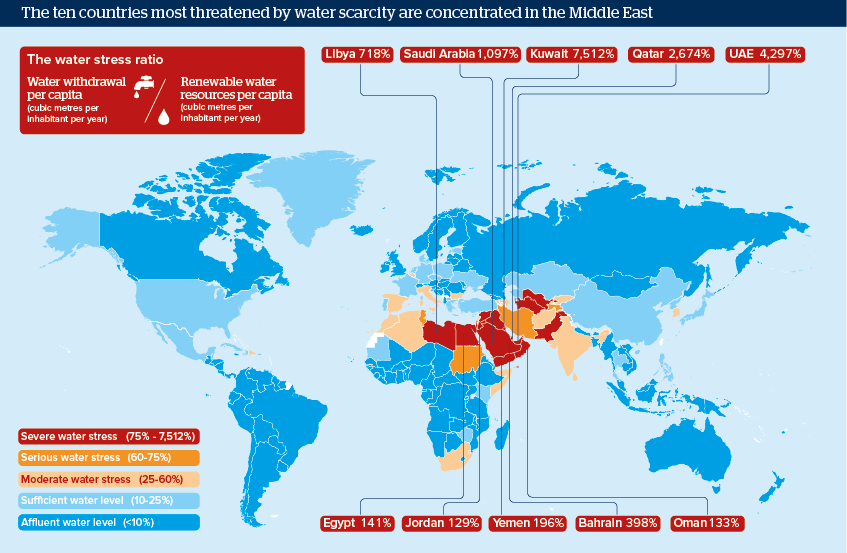Image Source: FAO Aquastat, Oxford Analytica
The Middle East is one of the most water-stressed regions in the world. This region is home to 15 out of the 20 of the world’s most water-scarce countries, (FAO, 2022). The region’s water resources are already under pressure from several factors, including population growth, climate change, and over-consumption. These pressures are expected to worsen in the future, leading to several serious consequences for the region.
Causes of Declining Water Resources
There are a several factors that are contributing to the decline of water resources in the Middle East. These include:
– Population growth: The population of the Middle East is growing rapidly, putting a strain on the region’s water resources.
– Climate change: Climate change is leading to more extreme weather events, such as droughts and floods. These events are disrupting the water cycle and making it more difficult for the region to access fresh water.
– Over-consumption: Water is being overused in the Middle East, particularly for agriculture and industrial purposes.
Consequences of Declining Water Resources
The decline of water resources in the Middle East is having several serious consequences, including:
– Water scarcity: The region is already facing water scarcity, and this is expected to worsen in the future.
– Conflict: Water is a scarce resource, and competition for water could lead to conflict between countries and communities.
– Health problems: Water scarcity can lead to waterborne diseases, such as cholera and typhoid.
– Economic disruption: Water scarcity can disrupt economic activity, such as agriculture and tourism.
Ways to Address the Decline of Water Resources
There are several ways to address the decline of water resources in the Middle East. These include:
– Improving water efficiency: Water efficiency measures can help to reduce the amount of water that is being used.
– Reducing water pollution: Water pollution is reducing the quality of water in the region. Reducing water pollution can help to make water more available for use.
– Developing new water sources: The region needs to develop new water sources, such as sustainable desalination plants and rainwater harvesting systems.
– Develop a related regulatory reform action plan with particular focus on water conservation, wastewater treatment and reuse, and water protection/conservation.
The Future of Water in the Middle East
The future of water in the Middle East is uncertain. However, if the region does not take action to address the decline of water resources, the consequences could be severe. The region needs to invest in water efficiency, reduce water pollution, and develop new water sources. By taking action now, the region can help to ensure a more sustainable future for its water resources.
How We Can Help
There are several things that we can do to help address the decline of water resources in the Middle East. These include:
– Reduce our water overconsumption: We can reduce your water consumption by taking shorter showers, fixing leaks, and watering our lawn less often.
– Support water-efficient products: When we are shopping for new appliances, look for products that are water efficient.
– Educate others about water conservation: Talk to our friends and family about the importance of water conservation.
– Pursue an integrated and holistic approach to managing both water demand and supply.
Collectively, Countries and citizens needs to be scaled up awareness and also build capacity of practitioners and institutions to meet the challenge of the growing water scarcity and climate change crisis in the MENA region.


Recent Comments